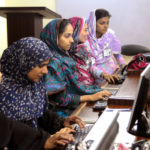A young American woman chooses to wear a head scarf as protection against vanity and the lustful gaze of men. By carefully combining the hijab with Western fashion, she finds she can express individual creativity, too.By Souheila Al-Jadda, Pacific News Service
SAN JOSE, Calif.- Mar 30, 2005-“What beautiful eyes you have!” People often say this to me, although, as a Muslim woman, I am covered from head-to-toe except for my face and hands. I have hazel-colored, almond-shaped eyes, usually lined with thick black eyeliner and mascara. When I hear this, I turn, flush and whisper, “Thank you.” Part of me is flattered, another part reserved. Several years ago, I decided to wear the Islamic veil (“hijab” in Arabic) to demonstrate my modesty. The aim of the hijab, usually worn as headscarf, is to hide a woman’s beauty. All Muslim women are required to wear the hijab according to Islam. But, with the exception of Iran and Saudi Arabia, women in Muslim countries have the freedom to choose to whether to wear it or not. They cannot be forced by their husbands or fathers. The hijab is an act of worship and protection against the lustful looks of others. When I interact with others, people judge me by my intellect and character, not my looks. The hijab also helps keep me from infusing sex into any interaction. There is an Islamic saying, “God is Beautiful and He loves Beauty.” As a Muslim woman, I am required to be beautiful, fresh and perfumed, but only for my husband, and especially at night in the privacy of the bedroom. Being a hijabi (one who wears hijab) has not been easy. I have had to give up some things that I love. I used to be proud of my hair, which is now covered. I would blow-dry it straight everyday. I still straighten my hair, using the best invention ever for women, my Vidal Sassoon Ceramic flat iron. My husband, brothers and my girlfriends are the only ones who can peak under the scarf. Also, I love make-up. While shopping, my favorite hobby is to visit the make-up section at department stores, trying on different shades of eye shadows and lipsticks. I still wear make-up, but I keep it light. Ironically, wearing the hijab and adding layers of clothing has allowed me to express my creativity through fashion. I always buy fashion magazines to check out the latest styles. As a hijabi, I have incorporated my keen fashion sense into a kind of hijabi, Western-style dress. Unlike the typical dark scarves and long black cloaks often seen women in parts of the Middle East, I like to play with different shades of color. Pastels, pinks and greens compliment my complexion. Depending on the occasion or how I feel on a certain day, I will dress in different color schemes. At work, I’ll throw on my favorite black pants with a blue turtleneck, a black suede blazer and a light blue chiffon scarf wrapped around the back of head. Going out with my friends, I’ll wear fitted pants and a shirt, covered with a sleek, long, ankle-length jacket. Or, I’ll put on a knee-length spaghetti-string dress with a long-sleeved body shirt and matching slacks underneath to cover my arms and legs. Then I must match the colors of my outfit with my handbag and shoes. Sometimes, I really go crazy! I might wear the scarf traditionally, or as a wrap behind the head like in Africa, which allows me to wear all kinds of long, dangly, sterling silver earrings. Usually, I feel secure when I leave home in my Islamic garb because I know that most people will not bother me. But sometimes, the opposite is true. Once, when I was riding the train to work, a middle-aged man, with sandy blond hair and crystal blue eyes got on, sitting next to me. “You have beautiful eyes,” he said. “You are not American, are you? Where are you from?” “Me, well, uh, yes actually, I am American, born-and-raised,” I said. “I am from Ohio.” “No, no, I mean where are you really from?” he said. “Girls from Ohio don’t have exotic eyes like yours.” “Well, you got me!” I said. “I am originally from the Middle East.” Proud of himself for guessing right, the blonde stranger smiled, showing his neatly lined white teeth. “So, are you dating anyone at the moment?” At that moment, I felt the hijab had lost its purpose. The scarf, the modest clothes, all this is supposed to protect me from these guys. What happened? Did I wear too much make-up? Was my scarf too attractive? Should I not have smiled at him? Was I flirting? In this sense, the hijab also helps a woman regulate her behavior and character. With the hijab, I cannot focus too much on my looks, which prevents me from comparing myself to others or developing vanity or conceit. I must speak to both men and women with humility, not arrogance. I have to admit though, sometimes, I like the positive attention, from non-Muslims and Muslims alike. Often, while walking in the street or in a store, out of nowhere a voice will say, “Assalamu Alaikum” or “Peace be with you” in Arabic. Then, my hijab becomes my identity, a raised flag that says, “Hey, I’m Muslim and I’m proud.” Other times, the hijab can be a hazard. Once, teenagers on a bus bombarded me with questions. “Are you a terrorist?” “Do you have bomb in your bag?” “Are you gonna blow this bus up?” Unfortunately, Muslim identity is misunderstood as something negative in much of the world, especially in Europe. In France, the government banned Muslim students from wearing the hijab in public schools. But I’m thankful to be living in America, where I have the right to choose how to dress and the best fashions to go along with my hijab. For now, I am confident in myself, knowing that my beauty lies underneath my veil.
Also of Interest from PNS
PNS contributor Souheila Al-Jadda is a freelance writer and an associate producer of “Mosaic: World News from the Middle East” on Link TV. |
||
|











